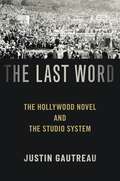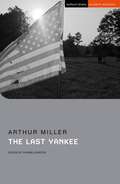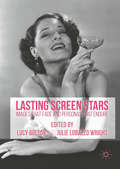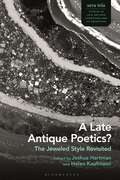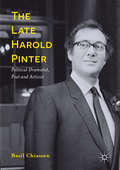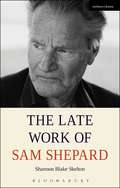- Table View
- List View
The Last Word: The Hollywood Novel and the Studio System
by Justin GautreauThe Last Word argues that the Hollywood novel opened up space for cultural critique of the film industry at a time when the industry lacked the capacity to critique itself. While the young studio system worked tirelessly to burnish its public image in the wake of celebrity scandal, several industry insiders wrote fiction to fill in what newspapers and fan magazines left out. Throughout the 1920s and 1930s, these novels aimed to expose the invisible machinery of classical Hollywood cinema, including not only the evolving artifice of the screen but also the promotional discourse that complemented it. As likeminded filmmakers in the 1940s and 1950s gradually brought the dark side of the industry to the screen, however, the Hollywood novel found itself struggling to live up to its original promise of delivering the unfilmable. By the 1960s, desperate to remain relevant, the genre had devolved into little more than erotic fantasy of movie stars behind closed doors, perhaps the only thing the public couldn't already find elsewhere. Still, given their unique ability to speak beyond the institutional restraints of their time, these earlier works offer a window into the industry's dynamic creation and re-creation of itself in the public imagination.
LAST WORD C: The Hollywood Novel and the Studio System
by Justin GautreauThe Last Word argues that the Hollywood novel opened up space for cultural critique of the film industry at a time when the industry lacked the capacity to critique itself. While the young studio system worked tirelessly to burnish its public image in the wake of celebrity scandal, several industry insiders wrote fiction to fill in what newspapers and fan magazines left out. Throughout the 1920s and 1930s, these novels aimed to expose the invisible machinery of classical Hollywood cinema, including not only the evolving artifice of the screen but also the promotional discourse that complemented it. As likeminded filmmakers in the 1940s and 1950s gradually brought the dark side of the industry to the screen, however, the Hollywood novel found itself struggling to live up to its original promise of delivering the unfilmable. By the 1960s, desperate to remain relevant, the genre had devolved into little more than erotic fantasy of movie stars behind closed doors, perhaps the only thing the public couldn't already find elsewhere. Still, given their unique ability to speak beyond the institutional restraints of their time, these earlier works offer a window into the industry's dynamic creation and re-creation of itself in the public imagination.
The Last Yankee (Student Editions)
by Arthur Miller'When the play focuses on the self-entrapment of the characters, Mr. Miller can be tender as well as trenchant' NEW YORK TIMES Two strangers meet in a New England psychiatric clinic, each visiting their admitted, depressed wife: one is a humble carpenter with seven children, the other a successful businessman in a childless marriage; both have been forgotten by the promise of the American Dream.Described by Miller as 'a comedy about a tragedy', this one-act play highlights the devastating consequences for those who fail to achieve the purported riches of the American Dream; a reality many face.This Methuen Drama Student Edition is edited by Ciarán Leinster, with commentary and notes that explore the play's production history (including excerpts from an interview with director David Thacker) as well as the dramatic, thematic and academic debates that surround it.
The Last Yankee (Student Editions)
by Arthur Miller'When the play focuses on the self-entrapment of the characters, Mr. Miller can be tender as well as trenchant' NEW YORK TIMES Two strangers meet in a New England psychiatric clinic, each visiting their admitted, depressed wife: one is a humble carpenter with seven children, the other a successful businessman in a childless marriage; both have been forgotten by the promise of the American Dream.Described by Miller as 'a comedy about a tragedy', this one-act play highlights the devastating consequences for those who fail to achieve the purported riches of the American Dream; a reality many face.This Methuen Drama Student Edition is edited by Ciarán Leinster, with commentary and notes that explore the play's production history (including excerpts from an interview with director David Thacker) as well as the dramatic, thematic and academic debates that surround it.
Last Year at Betty and Bob's: An Adventure
by Sher DoruffLast Year at Betty and Bob’s: An Adventure is the second in a series of three novellas emerging from a writing practice that taps the cusp of consciousness between dreaming and waking. A storyline, or genealogy, tinted a shade of RGB red, is fashioned by thinking through the felt unthought of this between space — a fabulation, an anarchive of what passes through. Lucid dreaming of this type is rife with allusions to conceptual and material goings-on, manifesting in awkward imaginaries. The dream personas are rendered as complex character amalgams with nomadic ages, sexes, genders, and phenotypes. Occurrences of lived “fact” elide with a hallucinatory real as speculation. In An Adventure, a feral feminist artist collective, The Bettys, inhabit a timeless Arcades Project. This is their experiment in wild hypo-consumerism. The event of Red Betty’s fall generates the advent of a turn. A cleaving. The intra-play of personal politics and activist artistic practices is surreally suffused with attention to color, to life and death, to lightness and heaviness.
The Lasting Influence of the War on Postwar British Film
by M. BoyceMany of the most celebrated British films of the immediate post-war period (1945-55) seem to be occupied with "getting on" with life and offering distraction for postwar audiences. It is the time of the celebrated Ealing comedies, Hue and Cry (1946) and Kind Hearts and Coronets (1949), Dickens adaptations, and the most ambitious projects of the Archers. While the war itself is rarely mentioned in these films, the war and the conditions of postwar society lie at the heart of understanding them. While various studies have focused on lesser known realist films, few consider how deeply and completely the war affected British film. Michael W. Boyce considers the preoccupation of these films with profound anxieties and uncertainties about what life was going to be like for postwar Britain, what roles men and women would play, how children would grow up, even what it meant - and what it still means today - to be British.
Lasting Screen Stars: Images that Fade and Personas that Endure
by Lucy Bolton Julie Lobalzo WrightLasting Stars examines the issue of stardom and longevity and investigates the many reasons for the persistence or disappearance of different star personas. Through a selection of chapters that look at issues such as inappropriate ageing, national identity and physical characteristics, this book will be the first volume to consider in depth and breadth the factors that affect the longevity of film stardom.The range of stars includes popular stars who are approached from fresh angles (Brando, Loren), less popular stars whose lower-profiles than their peers may be surprising (Taylor, Shearer) and stars whose national identity is integral to their perception as they age (Riva, Bachchan, Pavor). There are stars from the beginning of Hollywood (Valentino, Reid) to the present day (Jolie), and those who made uneasy transitions between countries (Mason), ages (Ringwald) and industrial eras (Keaton). The book examines the range of factors that affect how star images endure, including appropriate and inappropriate ageing (Griffith), race (Ice Cube) and digital technologies (Lee).
Lasting Value: Open Space Planning and Preservation Successes
by Rick PruetzAmericans are committing 'country-cide', says Rick Pruetz, FAICP, converting farms into suburban yards and channeling streams that once provided flood control, water purification, habitats, and recreational opportunities. But rather than rail against overdevelopment, this book celebrates communities succeeding in preservation. For ten years Pruetz explored communities that excel in saving their natural environment. In twenty-four illustrated vignettes, he captures the character of places from the volcanic range near downtown Albuquerque, New Mexico, to Minneapolis’s Grand Rounds park system, to farmland improbably preserved on Long Island. As the longtime city planner of Burbank, California, Pruetz offers more than an appreciation of these communities. He brings a planner’s-eye view of the practices behind their achievements. His detailed reports of creative preservation solutions mark the trail for planners, commissioners, and citizens who seek to preserve the green legacy in their own backyards.
Lasting Value: Open Space Planning and Preservation Successes
by Rick PruetzAmericans are committing 'country-cide', says Rick Pruetz, FAICP, converting farms into suburban yards and channeling streams that once provided flood control, water purification, habitats, and recreational opportunities. But rather than rail against overdevelopment, this book celebrates communities succeeding in preservation. For ten years Pruetz explored communities that excel in saving their natural environment. In twenty-four illustrated vignettes, he captures the character of places from the volcanic range near downtown Albuquerque, New Mexico, to Minneapolis’s Grand Rounds park system, to farmland improbably preserved on Long Island. As the longtime city planner of Burbank, California, Pruetz offers more than an appreciation of these communities. He brings a planner’s-eye view of the practices behind their achievements. His detailed reports of creative preservation solutions mark the trail for planners, commissioners, and citizens who seek to preserve the green legacy in their own backyards.
L'Atalante (BFI Film Classics)
by Marina WarnerL'Atalante is the work of French director Jean Vigo. It is a study of romantic love, told in a style influenced by surrealism, but still Vigo's own. This text is part of the 'BFI Film Classics' series. Each volume in the series presents a personal commentary on the film, together with a brief production history and a detailed filmography, notes and bibliography.
L'Atalante (BFI Film Classics)
by Marina WarnerL'Atalante is the work of French director Jean Vigo. It is a study of romantic love, told in a style influenced by surrealism, but still Vigo's own. This text is part of the 'BFI Film Classics' series. Each volume in the series presents a personal commentary on the film, together with a brief production history and a detailed filmography, notes and bibliography.
Late Antique and Medieval Art of the Mediterranean World
by Eva R. HoffmanLate Antique and Medieval Art of the Mediterranean World is a much-needed teaching anthology that rethinks and broadens the scope of the stale and limiting classifications used for Early Christian-Byzantine visual arts. A comprehensive anthology offering a new approach to the visual arts classified as Early Christian-Byzantine Comprised of essays from experts in the field that integrate the newer, historiographical research into 'the canon' of established scholarship Exposes the historical, geographical and cultural continuities and interactions in the visual arts of the late antique and medieval Mediterranean world Covers an extensive range of topics, including the effect that converging cultures in late antiquity had on art, the cultural identities that can be observed by looking at difference of tradition in visual art, and the variance of illuminations in holy books
A Late Antique Poetics?: The Jeweled Style Revisited (sera tela: Studies in Late Antique Literature and Its Reception)
by Joshua Hartman and Helen KaufmannThe poetry of the late Roman world has a fascinating history. Sometimes an object of derision, sometimes an object of admiration, it has found numerous detractors and defenders among classicists and Latin literary critics. This volume explores the scholarly approaches to late Latin poetry that have developed over the last 40 years, and it seeks especially to develop, complement and challenge the seminal concept of the 'Jeweled Style' proposed by Michael Roberts in 1989. While Roberts's monograph has long been a vade mecum within the world of late antique literary studies, a critical reassessment of its validity as a concept is overdue. This volume invites established and emerging scholars from different research traditions to return to the influential conclusions put forward by Roberts. It asks them to examine the continued relevance of The Jeweled Style and to suggest new ways to engage it. In a joint effort, the nineteen chapters of this volume define and map the jeweled style, extending it to new genres, geographic regions, time periods and methodologies. Each contribution seeks to provide insightful analysis that integrates the last 30 years of scholarship while pursuing ambitious applications of the jeweled style within and beyond the world of late antiquity.
A Late Antique Poetics?: The Jeweled Style Revisited (sera tela: Studies in Late Antique Literature and Its Reception)
The poetry of the late Roman world has a fascinating history. Sometimes an object of derision, sometimes an object of admiration, it has found numerous detractors and defenders among classicists and Latin literary critics. This volume explores the scholarly approaches to late Latin poetry that have developed over the last 40 years, and it seeks especially to develop, complement and challenge the seminal concept of the 'Jeweled Style' proposed by Michael Roberts in 1989. While Roberts's monograph has long been a vade mecum within the world of late antique literary studies, a critical reassessment of its validity as a concept is overdue. This volume invites established and emerging scholars from different research traditions to return to the influential conclusions put forward by Roberts. It asks them to examine the continued relevance of The Jeweled Style and to suggest new ways to engage it. In a joint effort, the nineteen chapters of this volume define and map the jeweled style, extending it to new genres, geographic regions, time periods and methodologies. Each contribution seeks to provide insightful analysis that integrates the last 30 years of scholarship while pursuing ambitious applications of the jeweled style within and beyond the world of late antiquity.
Late Antique Portraits and Early Christian Icons: The Power of the Painted Gaze (Routledge Research in Art and Religion)
by Andrew PatersonThis book focuses on the earliest surviving Christian icons, dated to the sixth and seventh centuries, which bear many resemblances to three other well-established genres of ‘sacred portrait’ also produced during late antiquity, namely Roman imperial portraiture, Graeco-Egyptian funerary portraiture and panel paintings depicting non-Christian deities.Andrew Paterson addresses two fundamental questions about devotional portraiture – both Christian and non-Christian – in the late antique period. Firstly, how did artists visualise and construct these images of divine or sanctified figures? And secondly, how did their intended viewers look at, respond to, and even interact with these images? Paterson argues that a key factor of many of these portrait images is the emphasis given to the depicted gaze, which invites an intensified form of personal encounter with the portrait’s subject.The book will be of interest to scholars working in art history, theology, religion and classical studies.
Late Antique Portraits and Early Christian Icons: The Power of the Painted Gaze (Routledge Research in Art and Religion)
by Andrew PatersonThis book focuses on the earliest surviving Christian icons, dated to the sixth and seventh centuries, which bear many resemblances to three other well-established genres of ‘sacred portrait’ also produced during late antiquity, namely Roman imperial portraiture, Graeco-Egyptian funerary portraiture and panel paintings depicting non-Christian deities.Andrew Paterson addresses two fundamental questions about devotional portraiture – both Christian and non-Christian – in the late antique period. Firstly, how did artists visualise and construct these images of divine or sanctified figures? And secondly, how did their intended viewers look at, respond to, and even interact with these images? Paterson argues that a key factor of many of these portrait images is the emphasis given to the depicted gaze, which invites an intensified form of personal encounter with the portrait’s subject.The book will be of interest to scholars working in art history, theology, religion and classical studies.
The Late Baroque Era: Vol 4. From The 1680s To 1740 (Man & Music)
by George J. BuelowCovers the development of musical life in the great centres of European music - Paris, Vienna, London and the courts of Italy and Germany. The contributions of Handel and Bach, and their lesser colleagues are set in their historical and sociological context.
Late Cainozoic Floras of Iceland: 15 Million Years of Vegetation and Climate History in the Northern North Atlantic (Topics in Geobiology #35)
by Thomas Denk Friðgeir Grimsson Reinhard Zetter Leifur A. SímonarsonBeing the only place in the northern North Atlantic yielding late Cainozoic terrestrial sediments rich in plant fossils, Iceland provides a unique archive for vegetation and climate development in this region. This book includes the complete plant fossil record from Iceland spanning the past 15 million years. Eleven sedimentary rock formations containing over 320 plant taxa are described. For each flora, palaeoecology and floristic affinities within the Northern Hemisphere are established. The exceptional fossil record allows a deeper understanding of the role of the “North Atlantic Land Bridge” for intercontinental plant migration and of the Gulf Stream-North Atlantic Current system for regional climatic evolution.’Iceland sits as a “fossil trap” on one of the most interesting biogeographic exchange routes on the planet - the North Atlantic. The fossil floras of Iceland document both local vegetational response to global climate change, and more importantly, help to document the nature of biotic migration across the North Atlantic in the last 15 million years. In this state-of-the-art volume, the authors place sequential floras in their paleogeographic, paleoclimatic and geologic context, and extract a detailed history of biotic response to the dynamics of physical change.’Bruce H. Tiffney, University of California, Santa Barbara ’This beautifully-illustrated monograph of the macro- and microfloras from the late Cenozoic of Iceland is a worthy successor to Oswald Heer’s “Flora fossilis arctica”. Its broad scope makes it a must for all scientists interested in climatic change and palaeobiogeography in the North Atlantic region. It will remain a classic for years to come.’David K. Ferguson, University of Vienna
The Late Films of Claude Chabrol: Genre, Visual Expressionism and Narrational Ambiguity
by Jacob LeighA member of the French New Wave group of filmmakers who first came to prominence at the end of the 1950s, Claude Chabrol has received the least amount of critical and scholarly attention, although he was the more prolific and commercially successful of them all. Jacob Leigh fills this lacuna by focusing on the last nine feature films of Chabrol's career, exploring his imagery, camerawork, use of sound and music, and performances, revealing the stylistic characteristics of his films while identifying the fundamental thematic issues that lie at the heart of his career-length exploration of the relationship between individuals and societies. Key areas of focus includes Chabrol's careful depiction of upper-class settings in films such as La Cérémonie (1995), Merci pour le chocolat (2000) and La Fille coupée en deux (2007) and on what Robin Wood and Michael Walker call 'the beast in man' (1970), the quasi-sympathetic 'id-figures' of which Le Boucher's Popaul is the most celebrated. Chabrol's 'id-figures' inherit the traits of Shadow of a Doubt's Uncle Charlie, Rope's Brandon and Strangers on a Train's Bruno, all three of whom have characteristics of the Nietzsche-quoting psychopath familiar in crime fiction. Additionally, The Late Films of Claude Chabrol considers the influence on Chabrol of a range of significant writers, including Patrick Hamilton, Patricia Highsmith, Charlotte Armstrong and Ruth Rendell.
The Late Films of Claude Chabrol: Genre, Visual Expressionism and Narrational Ambiguity
by Jacob LeighA member of the French New Wave group of filmmakers who first came to prominence at the end of the 1950s, Claude Chabrol has received the least amount of critical and scholarly attention, although he was the more prolific and commercially successful of them all. Jacob Leigh fills this lacuna by focusing on the last nine feature films of Chabrol's career, exploring his imagery, camerawork, use of sound and music, and performances, revealing the stylistic characteristics of his films while identifying the fundamental thematic issues that lie at the heart of his career-length exploration of the relationship between individuals and societies. Key areas of focus includes Chabrol's careful depiction of upper-class settings in films such as La Cérémonie (1995), Merci pour le chocolat (2000) and La Fille coupée en deux (2007) and on what Robin Wood and Michael Walker call 'the beast in man' (1970), the quasi-sympathetic 'id-figures' of which Le Boucher's Popaul is the most celebrated. Chabrol's 'id-figures' inherit the traits of Shadow of a Doubt's Uncle Charlie, Rope's Brandon and Strangers on a Train's Bruno, all three of whom have characteristics of the Nietzsche-quoting psychopath familiar in crime fiction. Additionally, The Late Films of Claude Chabrol considers the influence on Chabrol of a range of significant writers, including Patrick Hamilton, Patricia Highsmith, Charlotte Armstrong and Ruth Rendell.
The Late Harold Pinter: Political Dramatist, Poet and Activist
by Basil ChiassonThis volume is the first to provide a book-length study of Pinter’s overtly political activity. With chapters on political drama, poetry, and speeches, it charts a consistent tension between aesthetics and politics through Pinter’s later career and defines the politics of the work in terms of a pronounced sensory dimension and capacity to affect audiences. The book brings to light unpublished letters and drafts from the Pinter Archive in the British Library and draws his political poems and speeches, which have previously been overshadowed by his plays, into the foreground. Intended for students, instructors, and researchers in drama and theatre, performance studies, literature, and media studies, this book celebrates Pinter’s later life and work by discerning a coherent political voice and project and by registering the complex ways that project troubles the divide between aesthetics and politics.
The Late Work of Sam Shepard
by Shannon Blake SkeltonHailed by critics during the 1980s as the decade's 'Great American Playwright', Sam Shepard continued to produce work in a wide array of media including short prose, films, plays, performances and screenplays until his death in 2017. Like Samuel Beckett and Tennessee Williams in their autumnal years, Shepard relentlessly pressed the potentialities and possibilities of theatre. This is the first volume to consider Shepard's later work and career in detail and ranges across his work produced since the late 1980s.Shepard's motion picture directorial debut Far North (1988) served as the beginning of a new cycle of work. He returned to the stage with the politically engaged States of Shock (1991) which resembled neither his earlier plays nor his family cycle. With both Far North and States of Shock, Shepard signaled a transition into a phase in which he would experiment in form, subject and media for the next two decades. Skelton's comprehensive study includes consideration of his work in films such as Hamlet (2000), Black Hawk Down (2001), The Assassination of Jesse James by the Coward Robert Ford (2007) and Brothers (2009); issues of authenticity in the film and screenplay Don't Come Knocking (2005) and the play Kicking a Dead Horse (2007); of memory and trauma in Simpatico, The Late Henry Moss and When the World was Green, and of masculine and conservative narratives in States of Shock and The God of Hell.Lauded by critics in his lifetime and since his death in July 2017 as 'one of the most important and influential writers of his generation' (NY Times), Shepard 'excelled as an actor, screenwriter, playwright and director' (Guardian); this is a timely and important assessment of his work spanning the last three decades of his life.
The Late Work of Sam Shepard
by Shannon Blake SkeltonHailed by critics during the 1980s as the decade's 'Great American Playwright', Sam Shepard continued to produce work in a wide array of media including short prose, films, plays, performances and screenplays until his death in 2017. Like Samuel Beckett and Tennessee Williams in their autumnal years, Shepard relentlessly pressed the potentialities and possibilities of theatre. This is the first volume to consider Shepard's later work and career in detail and ranges across his work produced since the late 1980s.Shepard's motion picture directorial debut Far North (1988) served as the beginning of a new cycle of work. He returned to the stage with the politically engaged States of Shock (1991) which resembled neither his earlier plays nor his family cycle. With both Far North and States of Shock, Shepard signaled a transition into a phase in which he would experiment in form, subject and media for the next two decades. Skelton's comprehensive study includes consideration of his work in films such as Hamlet (2000), Black Hawk Down (2001), The Assassination of Jesse James by the Coward Robert Ford (2007) and Brothers (2009); issues of authenticity in the film and screenplay Don't Come Knocking (2005) and the play Kicking a Dead Horse (2007); of memory and trauma in Simpatico, The Late Henry Moss and When the World was Green, and of masculine and conservative narratives in States of Shock and The God of Hell.Lauded by critics in his lifetime and since his death in July 2017 as 'one of the most important and influential writers of his generation' (NY Times), Shepard 'excelled as an actor, screenwriter, playwright and director' (Guardian); this is a timely and important assessment of his work spanning the last three decades of his life.
Lateinamerikaberichterstattung der deutschen Presse: Struktur und Entstehungsbedingungen
by Regina CazzamattaDas vorliegende Buch zu Struktur und Entstehungsbedingung Lateinamerikas in der deutschen Presse basiert auf einer in dieser Dimension bis heute nicht vorhandenen empirischen Grundlage. Die Studie basiert auf 21.929 Beiträgen, von denen mithilfe einer geschichteten Stichprobe 4.164 in die Analyse einbezogen, ausgewertet und mit Korrespondenten-Interviews kombiniert wurden. Sie beleuchtet die Auswahlkriterien und Mechanismen der Berichterstattung zu Lateinamerika und füllte eine Forschungslücke zu einem Thema, das außenpolitisch extrem relevant ist. Das Buch betrachtet Themen und Merkmale des Mediendiskurses in kombinierter Form, stellt Länderprofile dar und sucht nach theoretischen Erklärungen für die Bildkonstruktionen. Die Studie kommt zum Ergebnis, dass es das Lateinamerikabild in der deutschen Presse nicht gibt, sondern sich eine Perzeption nach Ländern und Landesgruppen ausdifferenziert lässt. Die Forschungsarbeit ist über das Fachgebiet Medien- und Kommunikationswissenschaft hinaus interessant und bedeutet einen Gewinn für die Lateinamerikaforschung in Deutschland.
Lateness (POINT: Essays on Architecture #2)
by Peter Eisenman Elisa IturbeA provocative case for historical ambiguity in architecture by one of the field's leading theoristsConceptions of modernity in architecture are often expressed in the idea of the zeitgeist, or "spirit of the age," an attitude toward architectural form that is embedded in a belief in progressive time. Lateness explores how architecture can work against these linear currents in startling and compelling ways. In this incisive book, internationally renowned architect Peter Eisenman, with Elisa Iturbe, proposes a different perspective on form and time in architecture, one that circumvents the temporal constraints on style that require it to be "of the times"—lateness. He focuses on three twentieth-century architects who exhibited the qualities of lateness in their designs: Adolf Loos, Aldo Rossi, and John Hejduk. Drawing on the critical theory of Theodor Adorno and his study of Beethoven's final works, Eisenman shows how the architecture of these canonical figures was temporally out of sync with conventions and expectations, and how lateness can serve as a form of release from the restraints of the moment.Bringing together architecture, music, and philosophy, and drawing on illuminating examples from the Renaissance and Baroque periods, Lateness demonstrates how today's architecture can use the concept of lateness to break free of stylistic limitations, expand architecture's critical capacity, and provide a new mode of analysis.
